

How to use Snapchat for classroom learning success. Snapchat is turning into more than just an amusing app that lets people send pictures and videos, only to disappear after a few seconds.
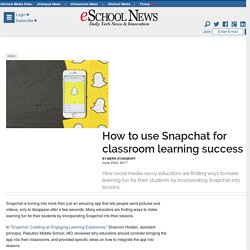
Many educators are finding ways to make learning fun for their students by incorporating Snapchat into their lessons. In “Snapchat: Creating an Engaging Learning Experience,” Shannon Holden, assistant principal, Republic Middle School, MO, reviewed why educators should consider bringing the app into their classrooms, and provided specific ideas on how to integrate the app into lessons. Benefits of Snapchat in Lessons As the most common social media platform for people ages 12-24, there is a strong chance most middle or high school students are already using Snapchat. The app has many benefits, and is a great opportunity for educators to take learning outside of the classroom. With the story and loop features, teachers can spread out content and take advantage of repetition—two effective ways to learn new material. Today… Facebook is allowed in class.
Usually in a classroom teachers would tell their students to stay off Facebook but today Morah Gail has come up with somewhat of an unconventional assignment.
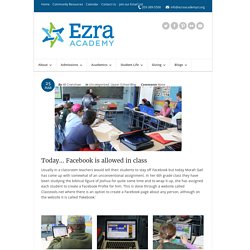
In her 6th grade class they have been studying the biblical figure of Joshua for quite some time and to wrap it up, she has assigned each student to create a Facebook Profile for him. This is done through a website called Classtools.net where there is an option to create a Facebook page about any person, although on the website it is called ‘Fakebook.’ At Ezra Academy integrating students with technology is one of our key goals. We understand that to prepare our students best for the future we must expose them with the tools that they will be surrounded by later in life. Twitter in the Classroom. As educators, we are preparing students to succeed in the real world.
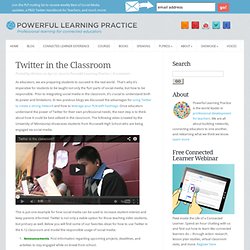
That’s why it’s imperative for students to be taught not only the ‘fun’ parts of social media, but how to be responsible. Prior to integrating social media in the classroom, it’s crucial to understand both its power and limitations. In two previous blogs we discussed the advantages for using Twitter to create a strong network and how to leverage your PLN with hashtags. Once educators understand the power of Twitter for their own professional needs, the next step is to think about how it could be best utilized in the classroom. The following video (created by the University of Minnesota) showcases students from Roosevelt High School who are being engaged via social media.
Students 'mystery skype' across the globe. HIGHLANDS RANCH - In Paula Neil's fifth grade classroom, she expects world class outcomes.
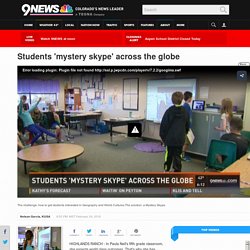
That's why she has engaged in 'mystery skypes' to engage her students in geography and world culture. "It takes them outside of where they're norm is, teaches them a lot about other cultures, other people," Neil said. She teaches at Wildcat Mountain Elementary School in Highlands Ranch. Skype. Skype helps you bridge geographic divides, work collaboratively with groups outside your classroom, and conduct question-and-answer sessions with consultants.

It's a useful videoconferencing tool for professional development, and the program can help homebound students keep in touch. Skype and other videoconferencing tools support inquiry-based learning, and like most technology tools, Skype can both augment the substance of curriculum content and serve as curriculum content area itself to teach a variety of skills. Skype (and other interviewing and collaborative experiences) occur in a proscribed timeframe, and you'll want to focus on planning skills to maximize how your class uses that allotted time. Pre-planning helps keep the conversation focused and on-topic. Discussion, and post-interview analysis of a video-conference foster both critical thinking skills about the subject and about proficient use of the technology. Skype can be an excellent medium for collecting oral histories. A @Snapchat Project Based Learning Attempt #EngChat #PBL. I wanted to change things up for my students the week before finals and after we finished the Mock Trial of Mark Twain.
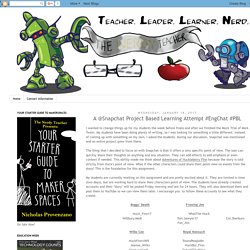
My students have been doing plenty of writing, so I was looking for something a little different. Instead of coming up with something on my own, I asked the students. During our discussion, Snapchat was mentioned and an entire project grew from there. The thing that I decided to focus on with Snapchat is that it offers a very specific point of view. The user can quickly share their thoughts on anything and any situation. Snapchat History Project. Students will create Snapchat Stories that depict an event from history and provide pictures and captions just like they do with their own Snapchats!
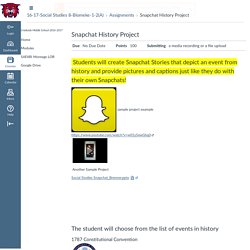
Sample project example (Links to an external site.)Links to an external site. Another Sample Project Social Studies Snapchat_Brenner.pptx The student will choose from the list of events in history 1787 Constitutional Convention 1791 Whiskey Rebellion 1803 Louisiana Purchase 1812-1815 War of 1812. Digital Literacy Lesson: Tweeting History. Subjects English --Creative writing History --U.S. history --World history Digital Literacy Grade Brief Description.
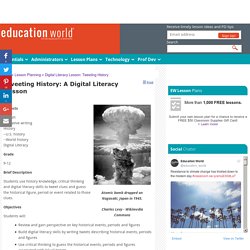
Snapchat and Vines in Classrooms - The Highlighter. Instagram in the Classroom - Madly Learning. I joined Instagram awhile ago but personally, or professionally didn't quite know what to do with it.
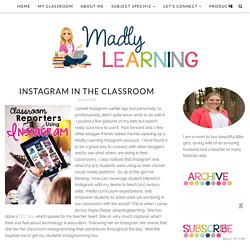
I posted a few pictures of my kids but wasn't really sure how to use it. Fast forward and a few other blogger friends talked me into opening up a Madly Learning Instagram account. I have found it to be a great way to connect with other bloggers and to see what others are doing in their classrooms. I also noticed that Instagram was what my 4/5 students were using as their chosen social media platform. So all of this got me thinking.